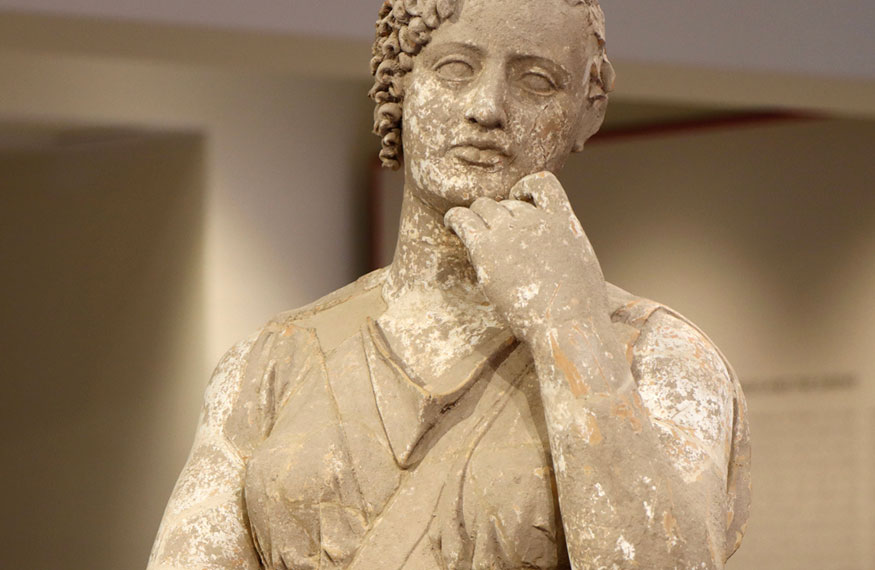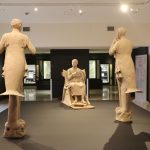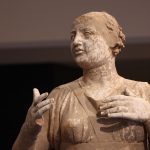Orpheus and the Sirens exhibition at MArTA in Taranto
EXHIBITIONS & EVENTS

The sculptural group of “Orpheus and the Sirens” consists of three life-sized terracotta statues. Originally characterized by vibrant polychromy and partially restored in modern times, it depicts the mythological episode from the Argonauts saga. The two Sirens sing their deadly song while, facing them, the singer Orpheus, with parted lips in a melodious chant, saves the sailors from danger. Seated on a throne bearing traces of its original colored decoration, he holds a fragment of a plectrum in his right hand and perhaps a lost stringed instrument in the other.
It is plausible that an artwork of such size and precision, created in Taranto at the end of the 4th century BC, adorned a wealthy tomb within the city. Monumental tombs decorated with terracotta elements are known to exist in the area.
This is a work of inestimable value, the result of clandestine excavation in an archaeological site in the area during the 1970s, and subsequently illicitly exported to the United States of America.
Orpheus and the Sirens – arrival in Taranto
THE MYTH AND THE STATUES
Apollonius Rhodius, in the Argonautica, recounts that upon their return from the quest for the Golden Fleece, the Argonauts arrived at the island of the Sirens, who bewitch and kill anyone who lands there. Here, the heroes are saved thanks to the intervention of the Thracian singer Orpheus, who, plucking his lyre and singing a lively tune, fills the ears of the sailors, thereby rescuing them from the voices of the maidens. According to some accounts, the Sirens, stunned by their defeat, throw themselves from the cliffs.
The two Sirens, depicted as bird-like creatures with female bodies, in accordance with the oldest iconography, stand on long legs with claws anchored to the rocks. They wear a short, waist-cinched garment that ends in a fan-shaped tail. One Siren sings, raising her arms upward, while the other, with nearly completely preserved curls, touches her chin while flexing the other arm in a posture often used to express grief.
Facing them, Orpheus, seated on a throne with traces of the original polychromatic decoration still visible, rests his feet on a footstool. He wears only a mantle, wrapped around his legs and over his left shoulder, leaving his chest exposed. His hair, likely crafted separately, is now lost. He barely parts his lips, perhaps in song. In his right hand, he grips a fragment of a plectrum, while in the other, he must have held a stringed instrument, now lost.
The myth is rare and peculiar and may reveal something about the deceased who chose it. The figure of Orpheus, in the 4th century BC, symbolizes the triumph of harmony over chaos, a fundamental concept in Pythagorean political and philosophical thought, particularly widespread in Magna Graecia. This concept was pursued by the philosopher Aristoxenus of Taranto and beloved by Archytas, who governed Taranto in the second half of the 4th century BC. It is conceivable, therefore, that the tomb adorned with the statues of Orpheus and the Sirens belonged to an initiate of the Orphic-Pythagorean religion.




THE INVESTIGATIVE HISTORY
Operation "ORPHEUS"
Operation Orpheus is part of a series of activities aimed at combating the illicit trafficking of Italian archaeological artifacts on the international stage, conducted by the Archaeology Section of the Cultural Heritage Protection Operational Department.
The initiative began several years ago when military personnel discovered that a well-known suspect involved in crimes against cultural heritage, utilizing an organization with international connections, had orchestrated a series of trafficking operations involving archaeological artifacts obtained from clandestine excavations in the district of Taranto.
During the course of the investigative activities, it was established that the prominent trafficker had played a role in the events related to the clandestine excavation and the illicit export, which occurred in the 1970s, of the sculptural group known as “Orpheus and the Sirens”.
Indeed, based on the identified documentation and conducted investigations, it was confirmed that these valuable artifacts had been excavated and discovered in fragments within the Taranto region by local tomb raiders. These fragments were then transferred to a well-known local receiver with connections to organized crime, who subsequently passed them on to another receiver with international contacts and ownership of an art gallery in Switzerland.
The sculptures, reduced to fragments, were entrusted to another entity specialized in transferring cultural assets abroad, which facilitated their transportation to Switzerland, where they were entrusted to a restorer who reassembled them into their original form.
After a period of storage in Switzerland awaiting a buyer, the statues were purchased by The Paul Getty Museum in Malibu (Los Angeles, USA).
Information shared with Assistant District Attorney Matthew Bogdanos of the District Attorney’s Office in Manhattan (DAO) and the close collaboration established with that office and Homeland Security Investigations led to the seizure of the priceless sculptural group and its repatriation for return to the national cultural heritage.
Orpheus and the Sirens at the National Archaeological Museum in Taranto












